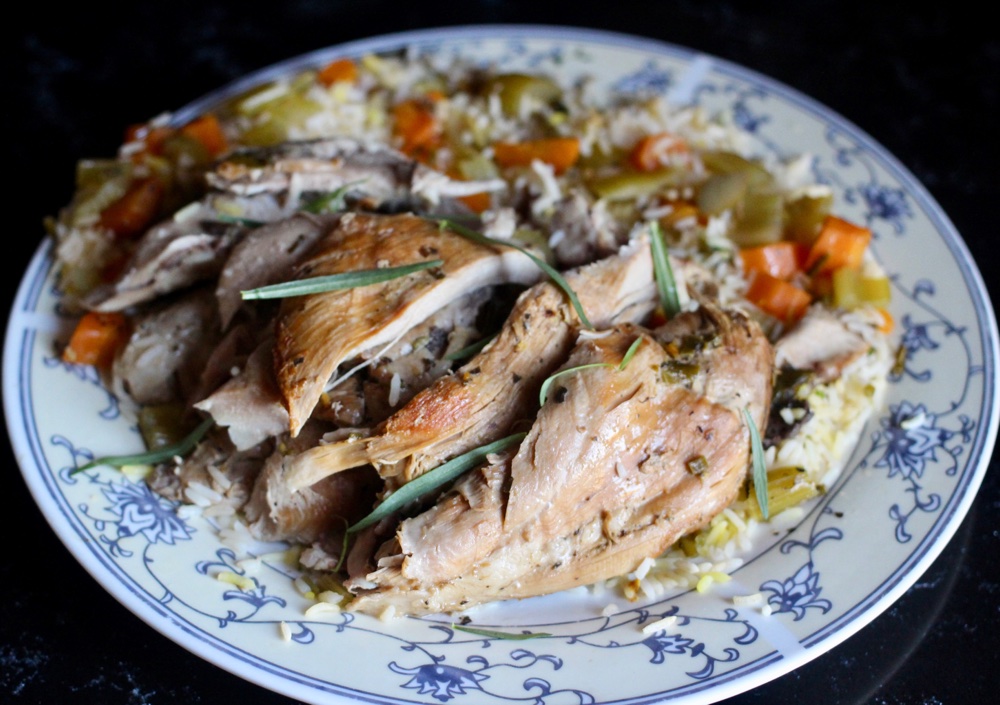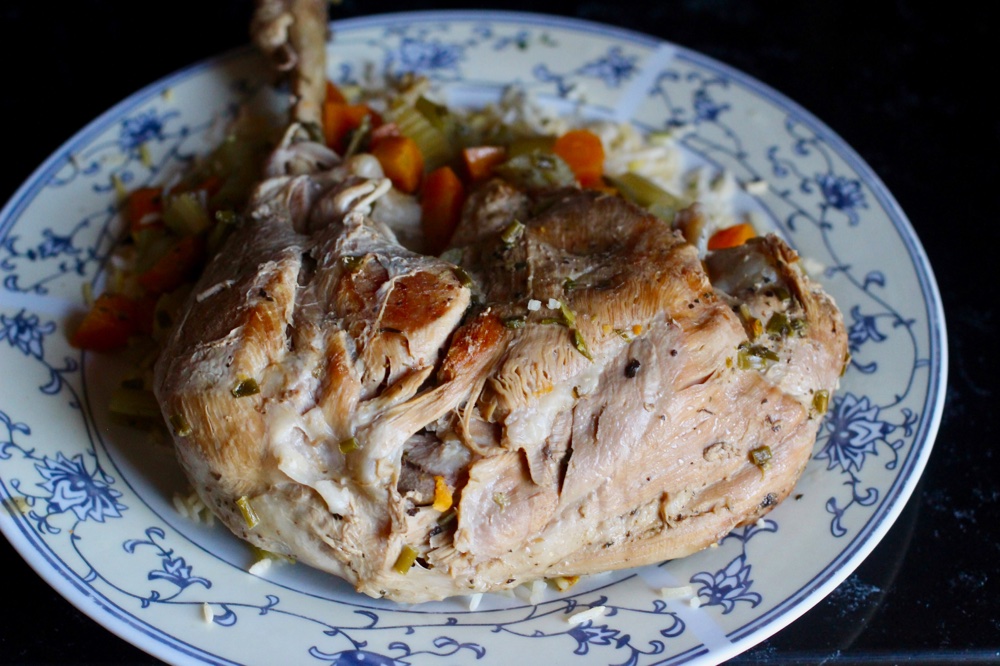
Rosé and turkey? Yes. White wine just wasn’t summery enough.
Plenty of recipes call for white wine, from butter sauces to mussels, and plenty call for red, from coq au vin to braised beef. But since turkey leg falls somewhere between chicken and beef in terms of white meat versus red meat (I put turkey leg around duck while turkey breast is pretty close to chicken), I figured rosé split the difference.
(I also happened to have some leftover in my fridge that was good enough to drink, but not my favourite). And doesn’t cooking with rosé sound awesome? You might not think braising is for summer, but it is when there’s rosé involved.
You can slow-cook this turkey, pressure cook (like I did) or braise it in the oven. Any way, it’ll be delicious.
Why turkey? Because sometimes you want a big chunk of meat. I didn’t want a bunch of chicken pieces whose skin would just end up flaccid in the pressure cooker and I didn’t want super fatty pork butt or lamb shoulder. Goodness knows I have enough duck fat in my fridge already from roasting three – count ’em, three – ducks this spring.
So, a little bit like my duck extravaganza, I went a little crazy on turkey. It’s not usually cheaper than chicken, but it’s a whole lot cheaper than duck. And it’s got more dark meat than chicken and giant legs that are really fun to braise. As with chicken legs or duck, you can strain out the braising liquid here and scrape off the excess fat the next day if you want.
And, really, does anyone need another chicken recipe?
This recipe is inspired by the Mediterranean, though mostly by the fact that I had these gorgeous little sundried tomatoes from my garden that I’d dehydrated at the end of last summer with some oregano. It’s best if you salt the turkey a day or even two in advance (a dry brine), so the meat is seasoned the whole way through, but if you can’t, try to season it the morning of the day you plant to make it. If you’re slow-cooking instead of pressure cooking or braising, don’t worry about it.
Rosé Braised Turkey Leg with Sundried Tomatoes and Olives and Rosemary
Serves 4-5
1 turkey leg
1 tbsp olive oil (or 1 tbsp reserved sundried tomato oil below)
2 branches celery, diced (or the white part of bok choy if you’re hurting from the spike in celery prices)
3 carrots, diced
2 green onions, finely chopped
2 sprigs fresh rosemary
1 small bunch chives, finely chopped
2 tbsp chopped green olives
1 tsp chopped capers
1/4 cup sundried tomatoes (if in oil, drained and oil reserved)
2 cups dry rosé
1 cup chicken or turkey stock (or a little more if braising in the oven without a daube – see step 9 below)
- A day or two in advance, score the thick turkey skin and sprinkle the turkey all over with about 1 1/2 tbsp of salt. Not all the salt will and on the turkey when you sprinkle it from above, like snow. That’s fine!
- Place the turkey in the fridge until needed. Note: If you’re using salted turkey stock, wipe off the turkey or rinse it and dry it before searing.
- Heat the olive oil in the pressure cooker or a sauté pan over medium heat and add the turkey fat-side-down before the pan gets hot. Render as much of the fat from the turkey as possible and pour it off into a glass container for another purpose (like making this again and using it in place of olive oil). This can take about 10 minutes.
- When most of the fat has melted and the skin is starting to crisp, flip the turkey over, raise the heat to medium-high and sear the other side for 2-3 minutes. Then sear the un-seared parts for a few minutes by standing the leg up in the pan.
- Remove the turkey leg to a plate and wipe away or pour off the excess fat again, leaving about 1 tbsp.
- Reduce the heat to medium-low and add the celery and carrots for 5-8 minutes, until softened. You want to sweat them without having them colour or burn.
- Add the white parts and some green parts of the green onions. Stir briefly, then add the rosé. Add the turkey back to the pan along with the chives, green olives, capers, sundried tomatoes, stock and most of the rosemary (remove the rosemary from its stem but add the stem too; leave a couple leaves to chop for garnish if you like). Bring to a boil.
- Transfer to a slow-cooker or over-safe casserole with a cover (like a dutch oven or just a dish that you can cover with foil) or if you’re using a pressure cooker, cover and bring to pressure.
- Pressure Cooker: Cook at high pressure for 18-20 minutes. If you salted the turkey a day in advance, 18 minutes should be enough.
Slow Cooker: Slow-cook on low heat for 7 hours or high for 4.
Oven: Cover and bake at 325˚F for 1 1/2 hours. You can even make this daube-style by rolling out a thick noodle of dough (just mix whatever flour with enough water to roll it out on a floured surface) and place it along the top of the casserole dish before placing the lid on top to create an air-proof seal. More on that here. - When done cooking using whatever method, take out the turkey leg and place it on a rack on top of a baking sheet or dish, skin-side-up, and broil it until the skin is crispy.
- Stir the remaining green onions into the vegetables. I strain the liquid to let the fat separate a bit, but if you rendered the fat before, this isn’t necessary. Besides, you’re hungry! Strain the leftover stock after dinner if you like. Then scrape off the fat on top the next morning, saving it for another use.
- Slice the leg into pieces (it should fall off the bone fairly easily). Serve with seasoned rice. I like cooking it in turkey or chicken stock (in this case I don’t add more salt to the rice when cooking it). Add a few more sundried tomatoes and the remaining rosemary pieces and drink some rosé.
- Hurray for summer!


Disclaimer: I’m being reimbursed for the cost of the turkey by the Turkey Farmers of Canada, but the recipe and words are my own.
Leave a Reply